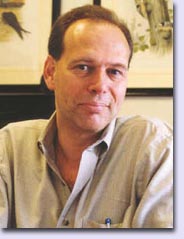
NEW YORK OVERHEARD:
“HYPERREALITY” by Russell Galen
A Note From Russell Galen (Philip K. Dick's long-time literary agent): For about ten years I wrote a column about the publishing industry called “New York Overheard” for Writer’s Digest. I had to give up the column when SCG was founded – things just got too busy – and by now, most of the pieces are dated, or I just don’t like them any more. But I think some of them stand the test of time and still contain useful advice about the craft of writing, the business of publishing, or both. You will find six of the better ones here on my Agency's web site.
First published in Writer’s Digest, March 1992
Copyright © 1992 by F&W Publications, Inc.
Recently I made a six-book deal with Vintage Books that both symbolizes and extends a revolutionary publishing trend. The books I sold are low-selling, out-of-print novels originally published as long as twenty years ago. The author, Philip K. Dick, is dead.
Dick wrote science fiction, which like most category fiction is dismissed as trash by non-fans. Yet he was a profound writer who used science fiction elements to explore the nature of reality in a thought-provoking and disturbing way. Still, mainstream book reviewers rarely paid attention to his work, and millions of readers who would have appreciated Dick’s work never even knew it existed.
My dream was to have these books published as trade paperbacks, which have higher prices, larger formats, classier covers, and are more prestigious than mass-market paperbacks. It was an unlikely idea – to sell out-of-print trash to a prestigious market – and for years it remained no more than a dream. But I had begun to notice a slowly developing trend that I thought might one day make the time right.
One day I made an appointment with Martin Asher, the editorial director of Vintage, a division of Random House and the trade paperback house I admired most. I prepared like a lawyer about to argue before the Supreme Court, planning to spend lunch arguing my case and then leave Marty with six of Dick’s best books and more than 250 reviews.
I never got the chance to lobby. When a trend’s time has come it rules the day.
“Let me explain my strange idea,” I said. “I want Vintage to republish Philip K. Dick.”
“What a great idea,” he said. “Would you consider a six-book deal?”
Asher had also noted the gathering force of the trend I’ve alluded to: the reading public is now more willing than at any time in many years to accept in its fiction hyper-real elements. That is, the supernatural, the fantastic, the technological, or anything else that goes beyond everyday life.
By the time my Vintage moment had arrived, the hyper-real story had made major inroads into mainstream literature.
There were the “magic realism” writers such as Gabriel García Márquez and Jorge Luis Borges. They depicted ordinary, contemporary worlds in which people live on farms or work in shops and the like, but in which the supernatural manifests itself under extraordinary circumstances.
There were the star science fiction and fantasy writers – from Arthur C. Clarke to David Eddings – who were discovered by broader audiences and began to show up on national bestseller lists.
There were the writers like Tom Clancy and Michael Crichton who wove into their fiction technologies so dazzling they seemed like magic.
There were the horror writers like Stephen King and Dean Koontz who wrote about dark supernatural forces.
There were novelists like Barbara Michaels who mixed the occult into their work.
There were historical fantasy writers like Marion Zimmer Bradley and Tim Powers whose worlds were accurate, carefully researched depictions of historical periods, except the magic really worked.
There were the major American literary writers such as Norman Mailer and Mark Helprin dealing with magic and other hyper-real themes.
And there were movies: Peggy Sue Got Married, Field of Dreams, Ghost – as well as the science fiction movies reaching huge mainstream audiences, such as Star Wars, E. T., and Terminator.
Some may think I’m stretching things when I attempt to tie all these manifestations to a single phenomenon. But I’m convinced they all reflect a dissatisfaction with the mundane that is felt by many people, and a longing to go beyond everyday experience. Is it any wonder that novelists who write about “real” life have been losing sales? And that they’ve often felt forced to come up with more extreme, bizarre stories – seeking the impact of the hyper-real without its magic or technology?
Clearly, Dick was ahead of his time. The very elements that once branded him not fit for mainstream audiences now seem enlightened and fresh, raising disturbing questions that force us to think about the implications of modern life; they now seem hyper-real rather than merely goofy. Androids so perfect they are indistinguishable from humans. Vast, living computer systems indistinguishable from God. Artificial memories so realistic they can’t be told from real ones. Is “real” life now that different from hyper-reality?
This doesn’t mean all writers should search out hyper-real elements to stuff into their fiction. But if these themes interest you, now is the time to develop hyper-real elements within a realistic, mainstream context. The two are no longer oil and water to the market. While such books still represent a minority of published mainstream fiction – as do the editors who feel comfortable with them – their numbers are increasing. And a novel of the hyper-real will stand out against the vast background of conventional manuscripts and get special attention. I can’t say often enough that merely being good isn’t sufficient in a depressed market; you have to be good and different, and this is one way of achieving that.

